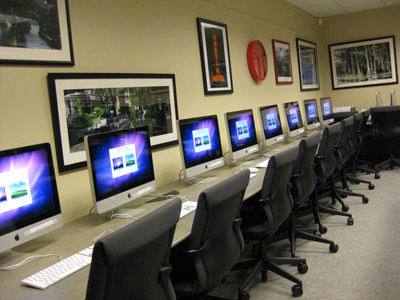About the DWRL
Mission
 The Digital Writing & Research Lab, operating under the auspices of the Department of Rhetoric and Writing at the University of Texas at Austin, explores how information technologies are changing the ways we produce and consume texts, the ways we argue, and how we can flexibly address these sociotechnical changes. Positioned at the intersection of rhetoric, writing, and technology, the Digital Writing & Research Lab dedicates itself—practically, pedagogically, and theoretically—to the identification and promotion of twenty-first century literacies. These literacies, both multiple and malleable, range from navigating online newsfeeds and participating in social networking sites to composing powerfully persuasive multimedia texts that require producing, sampling, and/or remixing media content.
The Digital Writing & Research Lab, operating under the auspices of the Department of Rhetoric and Writing at the University of Texas at Austin, explores how information technologies are changing the ways we produce and consume texts, the ways we argue, and how we can flexibly address these sociotechnical changes. Positioned at the intersection of rhetoric, writing, and technology, the Digital Writing & Research Lab dedicates itself—practically, pedagogically, and theoretically—to the identification and promotion of twenty-first century literacies. These literacies, both multiple and malleable, range from navigating online newsfeeds and participating in social networking sites to composing powerfully persuasive multimedia texts that require producing, sampling, and/or remixing media content.
In order to further these goals, a variety of digitally-oriented rhetoric classes are offered by the DWRL. In these classes, the DWRL is dedicated to providing 21st century technologies--computers, A/V equipment, a wide array of multimedia software appropriate to the rhetoric classroom, and more--to students in its undergraduate and graduate courses in order to support its goal of promoting digital literacy and research into digital rhetoric.
Furthermore, graduate students teaching in the DWRL participate in pedagogically-oriented research projects. These research projects aim to offer all instructors the tools they need to teach their students key communicative competencies in an increasingly technologized global environment. These competencies, which are a requisite part of any liberal arts education today and are necessary to critical thinking, effective communicating, and active citizenship, include the capacity to:
- proficiently use current software packages and technological devices,
- effectively collaborate, synchronously and asynchronously, across spatial barriers,
- confidently produce, analyze, and share information in various digital formats,
- and efficiently manage, analyze, and synthesize multiple streams of simultaneous information.
History
The lab's history exists in many places and it is constantly expanding and being revised. This process is reflected in the history section of the lab's Wikipedia page. But people and entities that move through or spin off from the lab also create historical traces. For example, former lab Assistant Director Jim Brown tells his history in the lab in his exit interview. One of the original project groups, The Daedalus Group, spun off and became a software company, and they have part of the lab's history on their website. The Daedalus Group also hosts a book called Language Learning Online: Theory and Practice in the ESL and L2 Computer Classroom, which you can download as a pdf. In that book, you will find the chapter "The Computer Writing and Research Lab: A Brief Institutional History" by John Slatin, the first director of the Computer Research Lab. Another reflection of our history is in what the lab calls itself. The CWRL was the successor to the CRL, the Computer Research Lab, and a precursor to the Digital Writing & Research Lab. Regardless of the name, lab members have always reflected on their projects, leaving traces of history for others to follow. Such was is the case with the Spring 2002 issue of Currents in Electronic Literacy or the end of the year showcases. Of course you can read all our publications--Currents in Electronic Literacy, The Journal for Undergraduate Media Projects, viz., Lesson Plans, and Blogging Pedagogy--to get a sense of the issues the lab has tackled in the past. But we're also leaving historical traces all the time as we update our status, tweet, upload videos, or upload audio. Why not interact with us and become part of our history?


